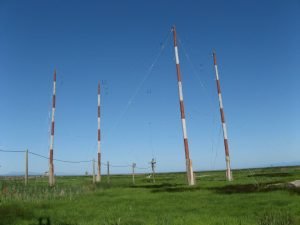
No matter which side of the “AM radio is dead” vs the “AM Radio revitalization” argument you support, it’s been a busy few weeks for ‘Ancient Modulation’ & there are plenty of insiders talking about it, making proposals or seeking solutions to it’s demise.

I’ve noted a new proposal that has little chance of succeeding from New Jersey broadcaster Larry Todd, owner of WRNJ-AM Hackettstown. His somewhat radical plan is to move AM broadcasters to the now unused VHF spectrum 45-50 mHz. This band of frequencies was once heavily populated by 2-way commercial users, some police & other first responder depts. The spectrum is now all but abandoned & resides just below one of the amateur “ham radio” band assignments. The spectrum is perfectly usable for AM analog or digital mode transmissions as ham operators on nearby frequencies have used the mode successfully for several decades. I would argue that 5 mHz is a rather small chunk of spectrum to re- populate with AM broadcasters & would suggest frequencies down to 42 mHz could be available. Motorola, Kenwood, GE & others no longer manufacture two-way radio gear for this band as users have moved to higher VHF & UHF spectrum. In addition, the world body responsible for frequency co-ordination – the ITU – has already designated 47-50 mHz as broadcasting spectrum. This proposal isn’t likely to gain serious consideration by the FCC which would counter with the same arguments used opposing the growing legion of professionals insisting that 76-88 mHz could & should be opened to AM operators. A further radical sidebar to Larry Todd’s proposal is that the FCC allow the Digital Radio Mondiale (DRM) system of digital transmission as opposed to the now-adopted IBOC HD system. The immediate argument against this, would be a lack of radio transmission & receiving equipment, requiring considerable investment by both broadcasters & consumers. Still, one must applaud Larry Todd for thinking outside the box & from a technical standpoint, his proposal stand point makes some sense.

In today’s Radioworld Beasley Broadcast Group VP of Engineering/CTO Mike Cooney shared his thoughts on the proposal for all-digital AM broadcasting. Cooney is also the chair of the NAB Radio Technology Committee. It would seem there is very little enthusiasm by the nation’s AM operators to adopt & support this proposal. The FCC currently has a rulemaking proposal which is still open for public comments until He states: “So far, very few broadcasters have shown interest due to the limited number of HD-compatible radios and due to the technical limitations”. He also points out: “Sometime back, we took an informal poll and almost no one said they would consider putting an all-digital AM on the air if the rules allowed. The number one issue for me is the lack of robustness of the signal. When you have a strong RF signal, the experience is pretty good and very similar to a low bit rate stream. It is not FM quality, but much better than our current AM signals. As you drive into weaker signal areas or approach strong power line interference, the signal frequently drops outs and goes to silence. The stronger the signal you have, the more infrequent the dropouts are, and you can drive under bridges, or have other environmental interference, and in many cases the signal is solid and does not drop. At night, the robustness is typically even worse, and our test station in Greenville, N.C., was almost unlistenable. That signal is 50 kW day and 10 kW night.” Mike Cooney expresses concern about the re-connect time when an all-digital transmission drops out, a factor that could cause listener tune-out. He also notes the problems with car radios, in particular, the issues surrounding electric cars: “A few manufacturers have already eliminated AM radios from their electric car models, and several more have made it clear they will not have AM radios in their future models,” he said. We have been told the cost to filter the interference to AM radio from the car gets into the hundreds of dollars per car. The cost to filter the AM becomes too great of a cost when compared to the benefits to the customer. In surveys, fewer and fewer people list AM radio as something they expect in the future car, and this can only hurt the long-term life of AM.” Others in the industry note that AM is “an old-folks” band & that younger millennials consume very little or no radio or TV, preferring online options instead. Younger listeners consider the AM band to be dead. All of this provides some food for thought as AM operators consider the merits & risks of investing in all-digital transmission.

Of final note is a positive article on AM stations that have risen above the ranks, notably with eclectic or exceptional programming that truly engages listeners in the markets noted. Writer Zack Stanton in the mag Politico provides an in-depth look at some unusual AM stations & the article is accompanied by some stunning photography. I was alerted to this by a reader, who provided a link in his comments & also one of our regular news reporters. Many out there are reading this article & commenting on it. A few of these stations I hear on a regular basis as a nightly “DXer” on the AM radio band. The article has a positive, yet sympathetic tone to it considering the doom & gloom opinions that prevail about the AM band.
We’ll continue to examine the good, the bad & the ugly of this struggling medium as AM radio attempts to survive & evolve in today’s consumer landscape.


Some comments may be held for moderation. (New users)